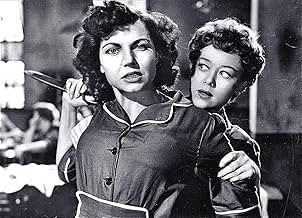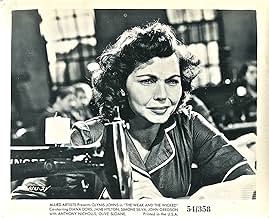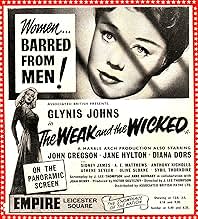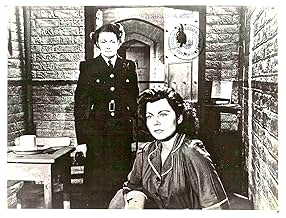Füge eine Handlung in deiner Sprache hinzuFrank "women in prison" story that sympathetically tracks several inmates through their imprisonment and subsequent return to society. Some are successfully rehabilitated; some are not.Frank "women in prison" story that sympathetically tracks several inmates through their imprisonment and subsequent return to society. Some are successfully rehabilitated; some are not.Frank "women in prison" story that sympathetically tracks several inmates through their imprisonment and subsequent return to society. Some are successfully rehabilitated; some are not.
Empfohlene Bewertungen
Although there was probably some serious intent behind the film's premise e.g. the open prison system, social comment on post-war England as class barriers are breaking down which are interspersed throughout, it is the gentle humour that lifts it above the mediocre. Superb cameos from the great Athene Seyler and Sybil Thorndike playing two friends who plot to 'do in' an elderly admirer is made a great deal of by the director. The central story involving Glynis Johns is well told and each of the film's subsequent yarns make for a light but thoroughly enjoyable whole.
A peculiar mixture this, with an attempt to portray something of the reality of contemporary womens' prisons on one hand, combined with comedy flashbacks and a fictional approach to crime on the other.
The story centres around Jean Raymond (Glynis Johns) who is the subject of an elaborate frame when she can't pay her gambling debts. In reality, a half competent barrister could have destroyed the case against her, should it have ever come to court in the first place, but here she's sent down for twelve months. There follows her experiences in the grim Blackdown Jail and then The Grange, a progressive 'prison without bars'. Many of the usual clichés of such films are avoided and the staff are shown as being very strict, but fair. One of the comedy episodes features a comical family of shoplifters headed by Sid James and Olive Sloane; Sid's prominent position in the cast list, despite a relatively brief appearance, is notable even at this stage of his career. Another piece of nonsense has a wooden Sybil Thorndike attempting to murder her husband, and then framing Athene Seyler for blackmail. By contrast the scenes in the prison hospital are more realistic, with Jane Hylton giving perhaps the best performance as Babs, haunted by the death of the baby she had neglected. Though third billed, Diana Dors is not very memorable in what is little more than a supporting role. A couple of years or so later she was to give her finest performance for the same director in YIELD TO THE NIGHT.
The finale, with the orchestra in full flow, is as contrived and sentimental as anything that Hollywood could produce. Despite or because of its various eccentricities, I quite enjoyed this.
The story centres around Jean Raymond (Glynis Johns) who is the subject of an elaborate frame when she can't pay her gambling debts. In reality, a half competent barrister could have destroyed the case against her, should it have ever come to court in the first place, but here she's sent down for twelve months. There follows her experiences in the grim Blackdown Jail and then The Grange, a progressive 'prison without bars'. Many of the usual clichés of such films are avoided and the staff are shown as being very strict, but fair. One of the comedy episodes features a comical family of shoplifters headed by Sid James and Olive Sloane; Sid's prominent position in the cast list, despite a relatively brief appearance, is notable even at this stage of his career. Another piece of nonsense has a wooden Sybil Thorndike attempting to murder her husband, and then framing Athene Seyler for blackmail. By contrast the scenes in the prison hospital are more realistic, with Jane Hylton giving perhaps the best performance as Babs, haunted by the death of the baby she had neglected. Though third billed, Diana Dors is not very memorable in what is little more than a supporting role. A couple of years or so later she was to give her finest performance for the same director in YIELD TO THE NIGHT.
The finale, with the orchestra in full flow, is as contrived and sentimental as anything that Hollywood could produce. Despite or because of its various eccentricities, I quite enjoyed this.
I remember seeing this film as a child when it first came out. I disliked it intensely BUT obviously it could not have been as terrible as I thought since I remember it well. I did like both Glynis Johns and Diana Dors. If only these old films were available to us now, I for one would be very happy!!! I remember the cinema where I saw it. It was a 'flea pit' in those days with poor decor and broken seats. The cinema screen was taller than it was wide and the edges were rounded. This was very odd, I thought. I remember that the story dealt with women in prison and followed their misadventures both while 'inside' and after release. I remember being very impressed with Glynis Johns voice and Diana Dors curves. I also remember that the story ended reasonably happy for one but not the other. I was happy when it was over as I had been promised an ice cream for sitting quietly through it!
"The Weak and the Wicked" is a film adaptation of the semi-autobiographical novel by Joan Henry about her experiences while in prison. In real life, she was a debutante who spent more than she had and eventually went to jail for passing a bad check. In this film, Jean (Glynis Johns) has a gambling problem and does pass a bad check at the gambling hall...but ultimately she's jailed because the people she defrauded set her up for a petty theft/fraud charge. Once in prison, you see what life is like there as well as what led some of the women to prison as shown in flashbacks.
Choosing Johns to play the lead was a stroke of brilliance. After all, I cannot think of any actress of the day that looked more innocent and sweet than her...so her plight is made worse since she doesn't look like she should be there. I have no idea if the real life Joan Henry looked so innocent.
So is the film any good? Yes, but it's certainly not like some of the broadly written and acted American women in prison films of the 1950s (such as "Caged") or the REALLY over-the-top an crazed film in the genre that came out about 1970 (they were a REALLY sleazy lot). Now as far as it being an exposee, the women in the film actually seemed to be treated pretty well considering they were criminals...so it's not much of an exposee and is quite civilized. Interesting, yes, but not what many likely want to see in a women in prison film! So, even with sexy blonde Diana Dors (sort of the British version of Jayne Mansfield) in the film, it's NOT a sleazy skin flick nor exploitational in any manner. The worst treatment in the film was towards the end when Joan received a stern talking to by the warden!
If you do watch this film, about 3/4 of the way through the picture is a marvelous flashback involving an elderly woman planning on murdering her nasty husband. It was, by far, the best part of the movie and this story, expanded, would have made for a great film itself.
By the way, in one of the flashbacks you see the Baden family. While not listed in the credits or IMDB, the son, Bob, is played by Anthony Newley.
Choosing Johns to play the lead was a stroke of brilliance. After all, I cannot think of any actress of the day that looked more innocent and sweet than her...so her plight is made worse since she doesn't look like she should be there. I have no idea if the real life Joan Henry looked so innocent.
So is the film any good? Yes, but it's certainly not like some of the broadly written and acted American women in prison films of the 1950s (such as "Caged") or the REALLY over-the-top an crazed film in the genre that came out about 1970 (they were a REALLY sleazy lot). Now as far as it being an exposee, the women in the film actually seemed to be treated pretty well considering they were criminals...so it's not much of an exposee and is quite civilized. Interesting, yes, but not what many likely want to see in a women in prison film! So, even with sexy blonde Diana Dors (sort of the British version of Jayne Mansfield) in the film, it's NOT a sleazy skin flick nor exploitational in any manner. The worst treatment in the film was towards the end when Joan received a stern talking to by the warden!
If you do watch this film, about 3/4 of the way through the picture is a marvelous flashback involving an elderly woman planning on murdering her nasty husband. It was, by far, the best part of the movie and this story, expanded, would have made for a great film itself.
By the way, in one of the flashbacks you see the Baden family. While not listed in the credits or IMDB, the son, Bob, is played by Anthony Newley.
Before he became popular directing Charles Bronson films, J. Lee Thompson directed two prison movies based on books written by his future wife, Joan Henry. Glynis Johns does very well as the gambler who is framed for insurance fraud and sent to prison for one year. Here she meets the inmates who relate their stories of crimes that sent them up for time: a shoplifter, a blackmailer, and a neglectful mother. She stops one from stabbing a cruel guard and is rewarded with a transfer to a prison without walls. It's also very touching in the visitation scenes with her fiancé and doctor (John Gregson) how she feels the stigma of her sentence from the outside world. Only beef with the film I have is that there is no flashback to explain what crime her best friend, Betty (Diana Dors) did to serve two years. Her chum is desperate to find a boyfriend, Norman, that never writes or visits.
Wusstest du schon
- WissenswertesJoan Henry's original novel 'Who Lie In Gaol' was based on her own experiences of prison. In debt from gambling, she took a forged cheque from a friend as a loan, and was convicted at the Old Bailey in 1951. Sentenced to twelve months, she served eight, primarily in Holloway Prison of which she was very critical, and later at Askham Grange Open Prison. The Glynis Johns character is based on her, although Henry thought her "a bit goody-goody".
- PatzerDuring the entire length of her prison term, Diana Dors maintains her artificially bleached and obviously waved hair style; Glynis Johns also maintains a more casual, but still very professionally maintained style from start to finish.
- Zitate
Jean Raymond: No one wants to give a girl with no talent a job.
- VerbindungenFeatured in A Bit of Scarlet (1997)
Top-Auswahl
Melde dich zum Bewerten an und greife auf die Watchlist für personalisierte Empfehlungen zu.
Details
- Erscheinungsdatum
- Herkunftsland
- Sprache
- Auch bekannt als
- Young and Willing
- Drehorte
- Wilton Place, Knightsbridge, London, England, Vereinigtes Königreich(dress shop where Jean worked - exterior of The Berkeley Hotel.)
- Produktionsfirma
- Weitere beteiligte Unternehmen bei IMDbPro anzeigen
- Laufzeit1 Stunde 28 Minuten
- Farbe
Zu dieser Seite beitragen
Bearbeitung vorschlagen oder fehlenden Inhalt hinzufügen

Oberste Lücke
By what name was The Weak and the Wicked (1954) officially released in India in English?
Antwort































